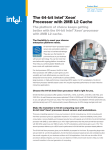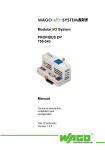Download Intel Xeon Processor 2.8GHz 1MB FSB800 BOX
Transcript
Platform Brief 64-bit Intel® Xeon Processor Dual Processor Server Platforms TM Make the transition to 64-bit computing now with Intel processor-based servers. ® The server platform of choice keeps getting better. Accomplish more than ever before with 64-bit Intel® Xeon processor-based platforms. TM Intel’s most versatile server platform Mitigate risk, enable growth, and lower costs with the server platform of choice: 64-bit Intel® Xeon processor-based servers. TM Find the freedom to focus more on your business with proven technology For over 35 years, companies have been turning to Intel to solve their toughest business and IT challenges. We developed the first true general-purpose microprocessor in 1974, and today, more than 80% of servers are built with Intel® architecture. With nearly 30 million Intel processor-based servers shipped since 1996, and a 20-year track record of delivering enterprise-class performance, you know you can count on Intel to deliver superior quality and reliability. And with over one million 64-bit processors already shipped, you can depend on 64-bit Intel® XeonTM processor-based servers to help you smoothly transition to 64-bit computing. 64-bit Intel Xeon processor-based server platforms are a key to business advantage. They give you the freedom to put more focus on your business with proven technology. They help you achieve greater flexibility and lower costs with optimized solutions. Dual processor (DP) server platforms based on the 64-bit Intel Xeon processor with 2MB L2 cache further enhance a proven platform, providing the versatility and cost-effectiveness you need for your enterprise front-end server, small/medium business (SMB), large business, or high-performance computing (HPC) needs. 2 Do more than ever before with ongoing platform innovation The power you need, the choices you want The power of this new generation of DP servers goes beyond the There are compelling reasons to move your business to 64-bit com- processor itself, to a platform that includes enhanced technologies puting now. The 64-bit Intel Xeon processor with 2MB L2 cache from an expanded L2 cache for superior performance to PCI Express gives you memory flexibility, application headroom, I/O headroom, serial I/O technology, which offers scalable bandwidth that is software- improved reliability, lower power consumption, and increased security. compatible with PCI and PCI-X*. The flexible server platform gives With advanced features such as DDR2 memory and PCI Express*, you a choice of multiple speeds spanning different performance DP server platforms based on the 64-bit Intel Xeon processor with levels and system price points. And you can take advantage 2MB L2 cache deliver up to 18%1 more performance than the pre- of a variety of validated, proven server platforms, which provides vious Intel Xeon processor with 1MB L2 cache at 800 MHz system for increased reliability. bus; second processor delivers up to a 93%2 boost in performance. 64-bit Intel Xeon processor-based server platforms continue to 64-bit Intel Xeon processors give you the flexibility to prepare for the undergo advancements in multi-core processors, cache, manage- future in the way that works best for you. Supporting larger data sets ability, security, memory, virtualization, I/O and more. And with a and both 32- and 64-bit applications, these servers allow the smooth robust platform roadmap geared to delivering a steady stream of migration of your business solutions to 64-bit applications new capabilities and value, Intel Xeon processor-based platforms at your own pace. are aimed at solving your highest-priority business and IT challenges By combining performance with advanced power management tomorrow as well as today. technology and enhanced security features, Intel Xeon processorbased servers can also help lower your operating costs and total cost of ownership (TCO). For more information on performance, please visit www.intel.com/go/xeon. 3 Maximum flexibility with 64-bit computing Compatibility Mode (64-bit OS/32-bit applications): This mode allows you to run existing 32-bit applications under When it comes to deploying 64-bit solutions, Intel® Enhanced Memory 64 Technology (Intel® EM64T)3 gives you a choice of three modes of operation. These platforms can switch between modes on a codesegment by code-segment basis for maximum flexibility. a 64-bit operating system (OS), which can greatly simplify 64-bit migrations. A 64-bit OS, drivers, and BIOS are required, and you may have to certify your applications for this new environment. Existing 32-bit “protected mode” applications Legacy Mode (32-bit OS/32-bit applications): This mode can continue to run without recompilation. 16-bit “protected delivers leading performance for 32-bit and 16-bit applications mode” application operation will depend on operating system and requires no changes to your existing code. For applications and driver support. On a traditional 32-bit platform, the OS and all that do not need more than 4 GB of memory, a 64-bit software applications typically share the 4 GB of available memory (in most migration may not be the best solution. An alternative strategy is cases, the OS reserves about half of this total memory for itself). By to scale your existing solution by upgrading your servers. Even running existing 32-bit applications under a 64-bit OS, you can pro- a simple platform upgrade can provide substantial performance vide 4 GB of memory for each application. Since this strategy in- improvements, especially if you’re replacing a three- to five-year-old volves a migration to a new OS, you will need to install compatible server. You may also benefit from a variety of new technologies that drivers and test your applications in the new operating system. can help reduce your TCO through improved manageability and power savings. The Platform of Choice Just Got Better Enable Growth Lower Cost Larger Cache SSE3 Demand-Based Switching DDR2 Memory PCI Express* Hyper-Threading Technology Intel® EM64T Platform Compatibility RAID Platform Validation Execute Disable Bit RAS Features Mitigate Risk Products and technologies designed and validated together to deliver greater end-user benefits. 4 Platform Feature User Benefit 2MB integrated L2 cache • More data can be stored closer to processor execution units for faster data access, resulting in higher system throughput and shorter system latency than previous generation Intel® Extended Memory 64 Technology • Enables extended memory addressability for server applications Demand-Based Switching with Enhanced Intel SpeedStep® technology • Enables platform and software power management features to lower average power consumption while maintaining application performance and improving acoustics PCI Express* serial I/O • • • • DDR2-400 memory • Provides up to 20% increase in memory bandwidth over DDR 333 • 40% lower power consumption vs. DDR 333 • Increased DIMMs per system for enhanced memory scalability Enhanced reliability and manageability • Many memory controller features, together with PCI Express RAS features combine to improve platform reliability vs. previous-generation platforms • The Intel® E7520 and Intel® E7320 chipsets include an SMBus port for remote management operation and support for a variety of third-party BMC (base management controller) and BIOS solutions Streaming SIMD Extensions 3 (SSE3) Instructions • Better multimedia and encryption/decryption processing than previous generation, along with support for more computationally intensive graphics Hyper-Threading Technology∆ • Improved processor utilization and system responsiveness in conjunction with the new Streaming SIMD Extensions 3 Instructions 800 MHz system bus • 1.5x system bus bandwidth increase over previous 533 MHz system bus platforms Next-generation I/O capable of up to 8 GB/s peak bandwidth Improved RAS features compared to PCI-X* Lower latency compared to PCI-X for improved I/O performance Software compatible with PCI-X to simplify parallel-to-serial transition Full 64-bit Mode: This mode delivers the memory benefits of 64-bit computing (up to 1 TB). A 64-bit OS, drivers, and BIOS are required, and existing 32-bit applications must be ported and optimized to take advantage of 64-bit addressing. This migration strategy provides 64-bit data manipulation and greatly extends memory capacity—up to 1 TB for platforms based on the 64-bit Intel Xeon processor. To take advantage of 64-bit application support you must have a complete 64-bit system in place including Increase performance and security while reducing costs Dual processor servers based on 64-bit Intel Xeon processor with 2MB L2 cache incorporate a number of other new and enhanced platform technologies that help boost business performance and lower TCO. Increase performance with an expanded L2 cache your application, operating system, and drivers. Existing 32-bit applications are supported without conversion in this environment, Experience faster response times with double the L2 cache, however, they are not able to take advantage of 64-bit addressing 2MB, as compared to the last generation of Intel Xeon processors. and the associated memory capacity. Because programs frequently use a subset of instructions or data repeatedly, the larger L2 cache provides higher performance in For additional information on Intel EM64T, please refer to http://developer.intel.com/technology/64bitextensions. many server benchmarks. 5 Enhance performance for data-intensive applications with PCI Express* And as the industry transitions from a parallel to a serial I/O With the increase in the compute performance of the 64-bit Intel platforms supporting PCI Express technology. With their scalable Xeon processor with 2MB L2 cache, the I/O (input/output) rate at architecture, these platforms provide a smooth upgrade path which data can be supplied to the processor increases correspond- to 10 Gigabit-based technologies. infrastructure, users can confidently invest in new DP server ingly. As processors become faster, the rate at which data needs to be supplied increases. In demanding computing situations, users running compute- and I/O-intensive applications may bump up Save on power costs using Demand-Based Switching (DBS) with Enhanced Intel SpeedStep® technology against the maximum usable bandwidth afforded by PCI-X. Without Enhanced Intel SpeedStep® technology, a feature of the 64-bit Intel sufficient memory bandwidth, the processor can sit idle, waiting for Xeon processor with 2MB L2 cache, enables platform and software data to be transferred, which affects system performance. At the power management features to lower average power consumption same time, the industry is transitioning from a parallel I/O (e.g., SCSI, while maintaining application performance. It can help reduce ATA) towards a serial I/O (e.g., SATA, SAS) interconnect infrastructure. average CPU power consumption by up to 25%, with minimal performance impact.4 A new serial I/O technology foundation is required to match the performance and capabilities of these next-generation serial inter- The processor’s operational states can vary based on usage. So when connects. PCI Express is the answer to both of these issues. utilization is high and maximum performance is desired, the processor can be switched to a higher operational state automatically. When PCI Express is architected to have lower memory and I/O latency compared to PCI. PCI Express is also capable of higher bandwidth compared to today’s PCI or PCI-X solutions. Higher bandwidth means more data can be transferred in the same unit of time. A PCI Express x1 (“by 1”) link has a bi-directional peak bandwidth of 500 MB/s, while x4 and x8 links are capable of 2 GB/s and 4 GB/s, respectively. usage is lower, transitioning to a lower operational state lowers the average power-consumption while maintaining application performance. There is even a state for maximum power conservation during system idle periods. Not only are power consumption levels reduced during lower operational states, but system acoustics can also be lowered by slowing down or halting fan operation entirely. The lower latency and the increased bandwidth help deliver the data speed required to fully utilize the processor’s capabilities. Improve security and reduce virus-related repairs with Intel’s Execute Disable Bit functionality Malicious buffer overflow attacks pose a significant security threat In addition to the many benefits of PCI Express, it is also a common I/O interface for mobile, desktop, workstation, storage and network technologies. to your business, increasing your IT resource demands and in some cases destroying data. In a typical attack, a malicious worm creates a flood of code that overwhelms the processor, allowing the worm to propagate itself to the network and other computers. The Intel Execute Disable Bit functionality can prevent certain classes of malicious “buffer overflow” attacks when combined with a supporting operating system. Execute Disable Bit allows the processor to classify areas in memory Current legacy PCI-X adapters can still be used while transitioning by where the application code can execute and where it cannot. When to new I/O adapters that take advantage of the inherent benefits a malicious worm attempts to insert code in the buffer, the processor of this new serial I/O technology. disables code execution, preventing damage or worm propagation. With the Intel E7520 and Intel E7320 chipsets, PCI Express Replacing older computers with Execute Disable Bit-enabled systems adapters have a direct path to either chipset’s memory controller can halt worm attacks, reducing the need for virus-related repairs. instead of having to go through a separate bridge component. With In addition, Execute Disable Bit may eliminate the need for software the direct attach to the memory controller, two stages are removed. patches aimed at buffer overflow attacks. ® ® This implementation minimizes the latency between the I/O adapter and the memory controller for improved I/O performance. In addition to the many benefits of PCI Express, it is also a common I/O interface for mobile, desktop, workstation, storage, and network technologies. This results in economies of scale, which in turn rapidly drives down the cost of PCI Express solutions. 6 Execute Disable Bit currently requires one of the following operating systems: Reduce your IT help desk costs with enhanced reliability and system management • Microsoft Windows* Server 2003 with Service Pack 1 As you know, system hardware is only a small fraction of the TCO. • Microsoft Windows XP* with Service Pack 2 Approximately 70% or more of TCO is attributable to the people • SUSE Linux* 9.2 who administer and maintain the hardware. One way to reduce • Red Hat Enterprise Linux 3 Update 3 TCO is by improving system manageability. See the Microsoft Windows Service Pack Roadmap for more information on Service Pack releases, or download Windows XP Service Pack 2. Multitask more effectively with Hyper-Threading Technology∆ Compatible with existing proven platforms The 64-bit Intel Xeon processor with 2MB L2 cache is compatible with a wide variety of existing platforms based on the previousgeneration Intel Xeon processor at 800 MHz system bus. Incorporating the best thinking from the broadest base of industry Hyper-Threading Technology (HT Technology) is a groundbreaking hardware, software and integration leaders, Intel’s world-class server technology that boosts computing performance to keep pace with solutions help you lower your TCO. With over $500 million in annual today’s applications and operating systems. HT Technology enables ISV investments and over 170,000 registered solution developers in a single processor to function as two “virtual” processors by executing the Intel community you can be sure that Intel-based servers have the two threads in parallel, allowing you and your software to multitask widest software application compatibility. In fact Intel-based servers more effectively than ever before. support more than 20 operating systems and thousands of applications, all validated and optimized for high-availability, performance and Increase responsiveness with Streaming SIMD Extensions 3 (SSE3) instructions reliability. Also take advantage of built-in advanced security features Thirteen new SSE3 instructions are fully supported by the 64-bit the value of your server investments? With solutions offered from Intel Xeon processor with 2MB L2 cache. Two of these new instruc- over 20,000 vendors worldwide you can adopt a flexible approach tions can improve thread synchronization over the previous-genera- to growth and change with stable and long-lasting solutions built tion processor supporting SSE2 technology, helping to increase on Intel platforms. to help improve uptime and avoid unplanned costs. How to extend processor utilization, enhance Hyper-Threading performance and increase system responsiveness. The 64-bit Intel Xeon processor with 2MB L2 cache is compatible with a wide variety of existing platforms based on the previous-generation Intel Xeon processor with 800 MHz system bus. ® Increase bandwidth and lower power consumption with DDR2-400 memory With the increase in processor bandwidth, it’s important to have faster, dual-channel memory designs that can keep up. DDR2-400 memory provides better memory bandwidth and reduced latency compared to older DDR 333 memory designs, and the power generated is lower by up to 40%, which helps reduce the overall TM system power requirements. Enterprise servers that require large memory configurations (such as those employing Intel EM64T) also benefit as the total power generated is reduced in comparison with DDR technology. 7 DP Server/HPC Performance 64-bit Intel Xeon Processor Comparison TM ® 64-bit Intel® Xeon processor 3.60 GHz with 2MB L2 cache performance gains over 64-bit Intel® Xeon processor 3.60 GHz with 1MB L2 cache TM TM SPECint*_rate_base2000 1.18 (Est.) SPECfp*_rate_base2000 1.17 (Est.) SPECjbb2000 1.12 WebBench 1.11 Star-CD 1.10 0.0 0.2 0.4 0.6 0.8 1.0 1.2 1.4 1.6 DATA SOURCE: SPECjbb2000, WebBench – Veritest Labs, SPECint_rate_base2000, SPECfp_rate_base2000, Star-CD – Intel® Corporation internal measurements. Data as of January 2005. DP Server/HPC Configuration: SPECint_rate_base2000, SPECfp_rate_base2000 – Intel® S3E1322 Server System (BIOS CYCRB043) with two 64-bit Intel® XeonTM processors 3.60 GHz with 2MB L2 Cache, 800 MHz FSB; 8 GB DDR2-400 memory; Hyper-Threading OFF; Red Hat* Enterprise* Linux 3, update3, 64bit, 2.4 kernel. 8.1 binaries for SPECcpu2000; (Disclaimer: SPECint2000 and SPECfp2000 benchmark tests reflect the performance of the microprocessor, memory architecture and compiler of a computer system on compute-intensive, 32-bit applications. SPEC benchmark tests results for Intel microprocessors are determined using particular, well-configured systems. These results may or may not reflect the relative performance of Intel microprocessor in systems with different hardware or software designs or configurations (including compilers). Buyers should consult other sources of information, including system benchmarks; to evaluate the performance of systems they are considering purchasing.) SPECjbb2000 – Veritest Labs – Intel® Server Board SE7520JR2 with Intel® E7520 chipset; Dual processor configuration with 64-bit Intel® XeonTM processor 3.60 GHz with 2MB L2 cache, 800 MHz FSB; 4 GB DDR2-400 memory; Hyper-Threading ON, Microsoft Windows* 2000, BEA WebLogic JRockit* 8.1 Service Pack 2 Java Virtual Machine (JVM). WebBench – Veritest Labs – Intel® Server Board SE7520JR2 with Intel® E7520 chipset; Dual processor configuration with 64-bit Intel® XeonTM processor 3.60 GHz with 2MB L2 cache, 800 MHz FSB; 4 GB DDR2-400 memory; 2 Intel® PRO/1000 Gigabit Server adapter; Hyper Threading ON; Microsoft Windows* 2003. Star-CD (ver. 3.150A) – Intel® S3E1322 Server System (BIOS CYCRB043) with two 64-bit Intel® XeonTM processors 3.60 GHz with 2MB L2 Cache, 800 MHz FSB; 8 GB DDR2-400 memory; Hyper-Threading OFF; Red Hat* Enterprise* Linux 3, update3, 64bit, 2.4 kernel. Manage software across heterogeneous systems IPMI helps enable management software that works across The Intelligent Platform Management Initiative (IPMI) is an heterogeneous server system hardware via: open hardware-management interface that uses a standardized • Instrumentation in server motherboard hardware message-passing interface. IPMI helps enable management software interoperability in a heterogeneous hardware environment. The Intel E7520 and Intel E7320 chipsets include an SMBus port that supports multiple third-party base management controller (BMC) and firmware solutions. Support for multiple third-party solutions not only provides flexibility and customer choice, it also represents a significant advancement in management software interoperability, greatly simplifying system management. • Standards-based architecture for systems and asset management • Interoperability between hardware and software management • Increased reliability through a hierarchy of sensors that report alerts to remote consoles • Common architecture that applies to the 3-tier server architecture prevalent in modern datacenters • Reduction in the TCO and administration with the use of common software user interfaces across multiple servers from multiple vendors 8 Reduce downtime with enhanced memory protection With the rapid price decline of memory, there has been an increase in the amount of memory usage in systems. With more memory in use, the potential for memory failure increases, which increases the impor- PCI Express Reliability/Availability/Serviceability (RAS) features keep you up and running PCI Express is rich in RAS capabilities: • Built-in clocking for Data Integrity Checking tance of memory reliability features in the platform. New DP Intel Xeon processor-based server platforms offer increased reliability over previous platforms through new features implemented in the chipset memory controller: • Advanced error logging and reporting through IPMI • Hot-plug5 capability simplifies replacement of failed devices and reduces system downtime, while allowing mix and match of • Memory scrubbing: The system constantly tests the memory for soft failures. When a failure is detected, a warning can be issued or spare memory can be invoked to ensure continued operation. 5 • Memory mirroring : Two copies of the memory’s content are peripherals and systems or I/O chassis from different vendors (something that is not generally possible in today’s environment) • A high-performance yet cost-effective RAID can be implemented on the server board using the Intel® IOP332 kept. If one set of memory fails, the other set enables continued I/O processor, designed to connect directly to the chipset’s operation and system availability. memory controller via PCI Express • On-line spare memory: Reserved memory can be invoked and brought online when there is a failure in the memory currently in use. • Dual-channel failover to single-channel operation: If memory in one of the two memory channels fails, the system can fail-over to single-channel operation, allowing continued system availability until the failed memory can be replaced. Summary Dual-processor server platforms based on the 64-bit Intel Xeon processor with 2MB L2 cache and the Intel E7520 chipset or the Intel E7320 chipset deliver outstanding computing power and flexibility, with the cost-effectiveness you need today and the headroom you need to migrate to 64 bit in the future. • x4 Single Device Data Correction (x4 SDDC): In a x4 DDR2 or DDR memory device, the Intel® x4 SDDC provides error detection and correction for 1 to 4 data bits within a single device or error detection for up to 8 data bits within two devices. In addition, these new platforms, backed by the Intel Xeon processor brand, offer optimized power consumption, plus improved platform reliability and manageability compared to previous-generation server platforms to further lower TCO and maximize your return on investment. 9 Find out more about Dual Processor Server Platforms based on the 64-bit Intel® XeonTM processor at www.intel.com/xeon 1 SPECint_rate_base2000 – Intel® Corporation internal measurements; data as of January 2005. Intel® S3E1322 Server System (BIOS CYCRB043) with two 64-bit Intel® XeonTM processors 3.60 GHz with 2MB L2 Cache, 800 MHz FSB; 8 GB DDR2-400 memory; Hyper-Threading OFF; Red Hat* Enterprise* Linux 3, update3, 64bit, 2.4 kernel. 8.1 binaries for SPECcpu2000; (Disclaimer: SPECint2000 benchmark tests reflect the performance of the microprocessor, memory architecture and compiler of a computer system on compute-intensive, 32-bit applications. SPEC benchmark tests results for Intel microprocessors are determined using particular, well-configured systems. These results may or may not reflect the relative performance of Intel microprocessor in systems with different hardware or software designs or configurations (including compilers). Buyers should consult other sources of information, including system benchmarks; to evaluate the performance of systems they are considering purchasing.) 2 SPECjbb2000 – Veritest measurement – Intel® Server Board SE7520JR2 with Intel® E7520 chipset; One and two processor configuration with 64-bit Intel® XeonTM processor 3.60 GHz with 2MB L2 cache, 800 MHz FSB; 4 GB DDR2-400 memory; Hyper Threading ON, Microsoft Windows* 2000, BEA WebLogic JRockit* 8.1 Service Pack 2 Java Virtual Machine (JVM). 3 Intel® EM64T requires a computer system with a processor, chipset, BIOS, OS, device drivers and applications enabled for Intel EM64T. Processor will not operate (including 32-bit operation) without an Intel EM64T-enabled BIOS. Performance will vary depending on your hardware and software configurations. Intel EM64T-enabled OS, BIOS, device drivers and applications may not be available. Check with your vendor for more information. 4 Based on preliminary Intel power testing with Intel® XeonTM processor 3.60 GHz with 800 MHz system bus. Intel Xeon processor with 2MB L2 cache expected to exhibit similar power consumption characteristics. Actual power savings will vary based on system configurations and workloads. 5 Memory mirroring and PCI-Express* Hot Plug are supported on the Intel® E7520 chipset only. ∆ Hyper-Threading Technology requires a computer system with an Intel® Pentium® 4 processor supporting Hyper-Threading Technology and an HT Technology-enabled chipset, BIOS and operating system. Performance will vary depending on the specific hardware and software you use. See http://www.intel.com/info/hyperthreading/ for more information including details on which processors support HT Technology. 10 There are compelling reasons to move your business to 64-bit computing now. The 64-bit Intel® XeonTM processor with 2MB L2 cache gives you memory flexibility, application headroom, I/O headroom, improved reliability, lower power consumption, and increased security. Contact United States and Canada Intel Corporation Robert Noyce Building 2200 Mission College Blvd. P.O. Box 58119 Santa Clara, CA 95052-8119 USA Europe Intel Corporation (UK) Ltd. Pipers Way Swindon Wiltshire SN3 1RJ UK Asia-Pacific Intel Semiconductor Ltd. 32/F Two Pacific Place 88 Queensway, Central Hong Kong, SAR Japan Intel Japan (Tsukuba HQ) 5-6 Tokodai Tsukuba-shi 300-2635 Ibaraki-ken Japan South America Intel Semicondutores do Brasil LTDA Av. Dr. Chucri Zaidan, 940-10° andar 04583-904 São Paulo, SP Brazil Find out more about Dual Processor Server Platforms based on the 64-bit Intel® XeonTM processor at www.intel.com/xeon Information in this document is provided in connection with Intel products. No license, express or implied, by estoppel or otherwise, to any intellectual property rights is granted by this document. Except as provided in Intel’s Terms and Conditions of Sale for such products, Intel assumes no liability whatsoever, and Intel disclaims any express or implied warranty, relating to sale and/or use of Intel products including liability or warranties relating to fitness for a particular purpose, merchantability or infringement of any patent, copyright, or other intellectual property right. Intel products are not intended for use in medical, life-saving or life-sustaining applications. Intel may make changes to specifications and product descriptions at any time, without notice. Designers must not rely on the absence or characteristics of any features or instructions marked “reserved” or “undefined.” Intel reserves these for future definition and shall have no responsibility whatsoever for conflicts or incompatibilities arising from future changes to them. *Other brands and names may be claimed as the property of others. Copyright © 2005 Intel Corporation. All rights reserved Intel, the Intel logo, Intel Xeon, Intel SpeedStep, and the Intel Inside logo are trademarks or registered trademarks of Intel Corporation or its subsidiaries in the United States and in other countries. Printed in USA 0205/SAJ/OCG/PP/2.5K Please Recycle 306383-001US























